| 1 |
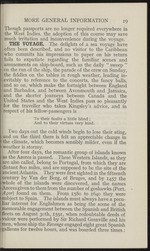 |
“...climate, which becomes sensibly milder, even if the
Iweather is stormy.
I After four days, the romantic group of islands known
las the Azores is passed. These Western Islands, as they
iare also called, belong to Portugal, from which they are
■distant 800 miles, and are supposed to be the site of the
: ancient Atlantis. They were first sighted in the fifteenth
(century by Van der Berg, of Bruges, and by 1457 the
whole of the islands were discovered, and the names
■Azoresgiven to them from the number of goshawks (Port.
\Afor) found on them. From 1580 to 1640 they were
I subject to Spain. The islands must always have a pecu-
liar interest for Englishmen as being the scene of the
memorable engagement between the Spanish and British
fleets on August 30th, 1591, when redoubtable deeds of
Ivalour Were performed by Sir Richard Grenville and his
men, whose ship the Revenge engaged eight great Spanish
talleons for twelve hours, and was boarded three times :...”
|
|
| 2 |
 |
“...P.M. 8 bells.
4-30 I It 12.30 P.M. I 8.30 „ I ,,
5-0 2 It 1.0 ,, 2 90 2 »»
5-3° 3 i-3° .. 3 9-3° »» 3 ..
6.0 4 2.0 ,, 4 10.0 ,, 4 ..
6.30 5 2.30 „ 5 10.30 „ 5 .. 1
7.0 6 30 b II.O „ 6 ,,
7-3° 7 3 30 „ 7 n.30 .. 7 ..
8.0 8 4-0 „ 8 Midnight 8 „
At the conclusion of each half-hour of the watch the
ship’s bell is struck : once for the first half-hour, twice
for the second, and so on, until “ eight bells ” is sounded.
The two short dog watches were arranged to make the
total number of watches seven, and so obviate the two
companies into which the crew is divided being on the
same watch on successive nights....”
|
|
| 3 |
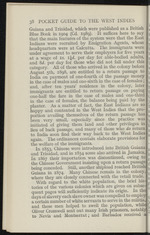 |
“...importation was discontinued, owing to a[
the Chinese Government insisting upon a return passage oj
being conceded. Still, another shipload reached British ^
Guiana in 1874. Many Chinese remain in the colony,
where they are closely connected with the retail trade.; H
With regard to the white population, the brief his-
tories of the various colonies which are given on subse- t
quent pages will sufficiently indicate its origin. In the
days of slavery each slave owner was compelled to employ ^
a certain number of white servants to serve in the militia, 1
and these men helped to swell the population, while ^
Oliver Cromwell sent out many Irish prisoners, notably Q
to Nevis and Montserrat; and Barbados received a...”
|
|
| 4 |
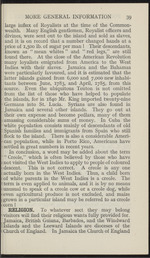 |
“...MORE GENERAL INFORMATION
39
! large influx of Royalists at the time of the Common-
| wealth. Many English gentlemen, Royalist officers and
■ divines, were sent out to the island and sold as slaves,
I and it is on record that a number changed hands at a
■ price of 1,500 lb. of sugar per man ! Their descendants,
. known as “ mean whites ” and “ red legs,” are still
: found there. At the close of the American Revolution
i many loyalists emigrated from America to the West
I Indies with their slaves. Jamaica and the Bahamas
1 were particularly favoured, and it is estimated that the
\ latter islands gained from 6,000 and 7,000 new inhabi-
I tants between June, 1783, and April, 1785, from this
I source. Even the ubiquitous Teuton is not omitted
jfrom the fist of those who have helped to populate
\ the islands, for in 1840 Mr. King imported twenty-nine
‘Germans into St. Lucia. Syrians are also found in
, Jamaica and several other islands. They go out at
j their own expense and become pedlars, many...”
|
|
| 5 |
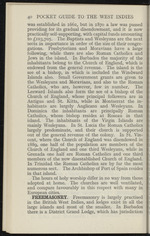 |
“...importance in order of the size of their congre-
gations. Presbyterians -and Moravians have a large
following, while there are also Roman Catholics and
Jews in the island. In Barbados the majority of the
inhabitants belong to the Church of England, which is
endowed from the general revenue. The island is the
see of a bishop, in which is included the Windward
Islands also. Small Government grants are given to
the Wesleyans and Moravians, and also to the Roman
Catholics, who are, however, few in number. The
Leeward Islands also form the see of a bishop of the
Church of England, whose principal followers are in
Antigua and St. Kitts, while in Montserrat the in-
habitants are largely Anglicans and Wesleyans. In
Dominica the inhabitants are principally Roman
Catholics, whose bishop resides at Roseau in that
island. The inhabitants of the Virgin Islands are
mainly Wesleyans. In St. Lucia the Roman Catholics
largely predominate, and their church is supported
out of the general revenue of the colony...”
|
|
| 6 |
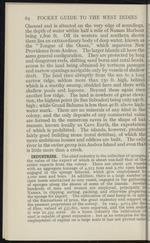 |
“...ambitious houses and edifices are built. The only &
river in the entire group is in Andros Island and even that
is little more than a creek.
is
INDUSTRIES. The chief industry is the collection of sponges,
the value of the export of which is about one-half that of the
entire exports from the colony. There are about 476 vessels
with an aggregate tonnage of 4,515 tons aad 2,760 open boats
engaged in the sponge fisheries, which give employment tc m
5,000 men and boys. In addition, thëre is a large number oi I,]
open boats unattached to any vessel, engaged in the gathering
of sponges along the shores of some of the islands. Several I
hundreds of men and women are employed, principally ir §
Nassau, in clipping, sorting, packing, and otherwise preparing
the sponge for export. The cultivation of sisal hemp is, in spite I
of the fluctuations of price, the great mainstay and support oi ^
the peasant proprietors of the colony. In 1924, 4>°74>5^o lbs,
of fibre, valued at ^37,861, were exported, and the...”
|
|
| 7 |
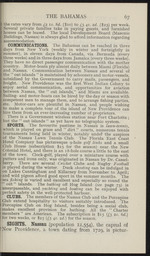 |
“...carry mails, passengers, and
[freight. New Providence was the first West Indian Colony to
[enjoy aerial communication, and opportunities for aviation
[between Nassau, the “ out islands,” and Miami are available.
I Sailing- and motor-boats can be hired by the day or season with
I competent men to manage them, and to arrange fishing parties,
{etc. Motor-cars are plentiful in Nassau, and people wishing
I to make a complete tour of the island of New Providence can
[hire them from an ever-increasing number of proprietors.
I, There is a Government wireless station near Fort Charlotte ;
but the " out islands ” as yet have no telegraphic system.
SPORTS. The favourite pastime in Nassau is lawn-tennis,
which is played on grass and " dirt ” courts, numerous tennis
f tournaments being held in winter, notably under the auspices
j of the Nassau Lawn Tennis- Club. The Florida East Coast
Hotel Company has picturesque g-hole golf links and a small
Club House (subscription $25 for the season) near the New
[Colonial...”
|
|
| 8 |
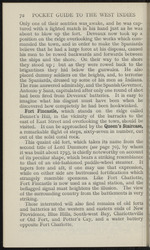 |
“...admirably, and the Spanish Governor,
Antonio y Sanz, capitulated after only one round of shot
had been fired from Deveaux’ batteries. It is easy to
imagine what his disgust must have been when he
discovered how completely he had been hookwinked.
Fort Fincastle, which stands on the ridge called
Bennet’s Hill, in the vicinity of the barracks to the
east of East Street and overlooking the town, should be
visited. It can be approached by the Queen’s Staircase,
a remarkable flight of steps, sixty-seven in number, cut
out of the solid coral rock.
This quaint old fort, which takes its name from the
second title of Lord Dunmore (see page 70), by whom
it was built about 1793, is chiefly noteworthy on account
of its peculiar shape, which bears a striking resemblance
to that of an old-fashioned paddle-wheel steamer. It
tapers fore and aft, if one may use that expression,
while on either side are buttressed fortifications which
strangely resemble sponsons. Like Fort Charlotte,
Fort Fincastle is now used as...”
|
|
| 9 |
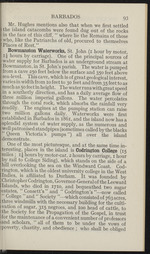 |
“... college in the West
Indies, is affiliated to Durham. It was founded by
Christopher Codrington, Governor-General of the Leeward
Islands, who died in 1710, and bequeathed two sugar
estates* Consett s and “ Codrington’s ”—now called
) College ’’and “ Society ”—which consisted of 763 acres,
three windmills with the necessary building for the culti-
vation of sugar, 315 negroes, and 100 head of cattle, to
fhe Society for the Propagation of the Gospel, in trust
lor the maintenance of a convenient number of professors
land scholars, all of them to be under the vows of
ipoverty, chastity, and obedience; who shall be obliged...”
|
|
| 10 |
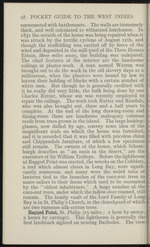 |
“...being repaired when it
was struck by the terrific cyclone of August nth, and i
though the scaffolding was carried off by force of the
wind and deposited in the mill-yard of the Three Houses
Estate, three miles away, the building was uninjured.
The chief features of the interior are the handsome j
ceilings in plaster-work. A man named Warren was
brought out to do the work in the old slavery days as a
militiaman, when the planters were bound by law to
leaven their holding of blacks with a certain number of
white men. But though he is generally credited with
it he really did very little, the bulk being done by one
Charles Rutter, whose son was recently employed to
repair the ceilings. The work took Rutter and Randals, \
who was also brought out, three and a half years to!
complete. At the end of the long drawing-room and;
dining-room there are handsome mahogany columns
made from trees grown in the island. The large looking-:
glasses, now dulled by age, convey some idea of the
magnificent scale...”
|
|
| 11 |
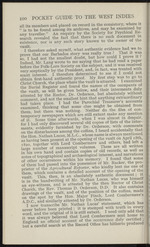 |
“...temporary newspapers which are still extant make any mention
of it. Some time afterwards, when I was almost in despair,
for I had only discovered several old copies of lists of the inter-
ments. evidently furnished by Dr. Orderson, with comments
on the disturbances among the coffins, I heard accidei^ally that
the Hon. Nathan Lucas, M.L.C., whose name is always mentioned
as having been present at the opening of the vault on April 18th ,
1820, together with Lord Combermere and others, hadleft a
large number of manuscript volumes. These are all written
in his own hand and contain copies of old records, as well as
notes of topographical and archaeological interest, and narrations
of other occurrences within his memory. I found that some
of them had passed into the possession of Mr. Racker, the pro-
prietor of the Agricultural Reporter, who kindly lent me one of
them, which contains a detailed account of the opening of the
vault This, then, is an absolutely authentic document, it
S\n the handwriting...”
|
|
| 12 |
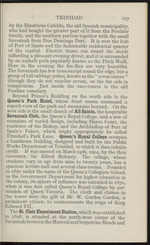 |
“...southern portion together with the small
Savannah from Don Domingo Dert. It is now the hub
of Port of Spain and the fashionable residential quarter
of the capital. Electric trams run round the inside
(affording a pleasant evening drive), and it is surrounded
by an asphalt path popularly known as the Pitch Walk.
Here in the evening the fire-flies are very beautiful.
The Savannah has few trees except round the edge, but a
group of tall cabbage palms, known as the “ seven sisters ”
(though they do not number seven), on the far side is
conspicuous. Just inside the race-course is the old
Peschier cemetery.
Beyond Prince’s Building on the south side is the
■ Queen’s Park Hotel, whose front rooms command a
superb view of the park and mountains beyond. On the
west side is the small church of All Saints, the hospitable
Savannah Club, the Queen’s Royal College, and a row of
mansions of varied design, including Hayes Court, the
residence of the Bishop, and the Archbishop of Port of
Spain’s Palace, which...”
|
|
| 13 |
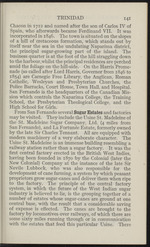 |
“...the
first central factory erected in the British West Indies,
having been founded in 1870 by the Colonial (later the
New Colonial) Company at the instance of the late Sir
: Nevile Lubbock, who was also responsible for the
development of cane farming, a system by which peasant
proprietors grow sugar-canes and deliver them when ripe
to the factory. The principle of the central factory
I system, in which the future of the West Indian sugar
industry is believed to lie, is the grouping together of a
number of estates whose sugar-canes are ground at one
> central base, with the result that a considerable saving
'1 of expense is effected. The canes are brought to the
factory by locomotives over railways, of which there are
I some sixty miles running through or in communication
with the estates that feed this particular Usine. There...”
|
|
| 14 |
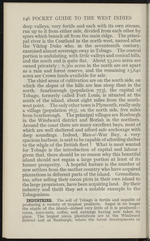 |
“...northern.
Around the coast there are many excellent bays, most of
which are well sheltered and afford safe anchorage with
deep soundings. Indeed, Man-o’-War Bay, a very
spacious harbour, is said to be capable of affording shelter
to the whple of the British fleet! What is most wanted
for Tobago is the introduction of capital and labour ;
given that, there should be no reason why this beautiful
island should not regain a large portion at least of its
former prosperity. A hopeful feature is the number of
new settlers from the mother country who have acquired
plantations in different parts of the island. Grenadians,
too, after selling their cocoa plots in their own island to
the large proprietors, have been acquiring land. By their
industry and thrift they set a notable example to the
Tobagonians.
INDUSTRIES. The soil of Tobago is fertile and capable of
producing a variety of tropical products. Sugar is no longer
the staple of the island—indeed very little of it is produced—
cocoa, coco-nuts...”
|
|
| 15 |
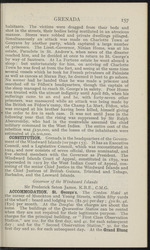 |
“...GRENADA
157
I habitants. The victims were dragged from their beds and
I shot in the streets, their bodies being mutilated in an atrocious
I manner. Stores were robbed and private dwellings pillaged.
I Simultaneously an' attack was made on Charlotte Town or
I Gouyave by another party, which captured a large number
I of prisoners. The Lieut.-Governor, Ninian Home, was at his
I estate. Paraclete in St. Andrew’s, when news of the disaster
I reached him, and he decided at once to return to St. George’s
I by way of Sauteurs. At La Fortune estate he went aboard a
I sloop : but unfortunately for him, on arriving off Charlotte
I Town he was fired at from the fort, and seeing at the same time
I several vessels which he took for French privateers off Palmiste
I as well as canoes aLMaran Bay, he deemed it best to go ashore.
I No sooner had he1 landed than he was made a prisoner and
I marched off to Fédon’s headquarters, though the captain of
I the sloop managed tó reach St. George’s in safety. Poor...”
|
|
| 16 |
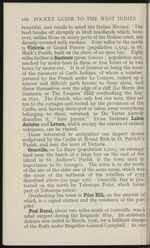 |
“...The
land breaks off abruptly in bluff headlands which, how-
ever, unlike those on many parts of the Italian coast, are
densely covered with verdure. Four miles to the north
is Victoria or Grand Pauvre (population 1,514), in St.
Mark’s Parish, built on the shore of an open bay. Eight
miles farther is Sauteors (pron. Soteers ; population 960),
reached by motor-boat in three or four hours or in two
hours by motor-car. It is of interest as being the scene
of the massacre of Carib Indians, of whom a number,
pursued by the French under Le Compte, rushed up a
narrow and difficult path known to them alone, and
threw themselves over the edge of a cliff (Le Mome des
Sauteurs, or The Leapers’ Hill) overlooking the bay,
in 1650. The French, who only lost one man, then set
fire to the cottages and rooted up the provisions of the
Caribs, and, having destroyed or taken away everything' I
belonging to them, returned, as Du Tertre naïvely |
describes it, “bien joyeux.” From Sauteurs Lakes [i
Antoine and Levera...”
|
|
| 17 |
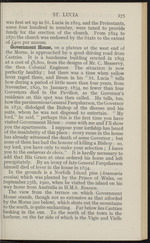 |
“...ST. LUCIA
175
was first set up in St. Lucia in 1819, and the Protestants,
some four hundred in number, were taxed to provide
funds for the erection of the church. From 1824 to
1870 the church was endowed by the State to the extent
. of £400 per annum.
Government House, on a plateau at the west end of
the Mome, is approached by a good driving road from
1 Castries. It is a handsome building erected in 1895
at a cost of £8,800, from the designs of Mr. C. Messervy,
the then Colonial Engineer. The situation is now
perfectly healthy; but there was a time when yellow
fever raged there, and Breen in his “ St. Lucia ” tells
how during a period of little more than four years, from
November, 1829, to January, 1834, no fewer than four
Governors died in the Pavilion, as the Governor’s
residence on this spot was then called. He tells, too,
how the parsimonious General Farquharson, the Governor
in 1832, dislodged the Bishop of the diocese and his
suite, whom he was not disposed to entertain. “ My
lord...”
|
|
| 18 |
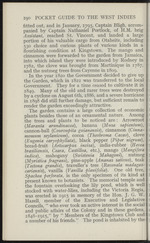 |
“...Spachea perforata, is the only specimen of its kind at S
present known to botanists. The memorial temple and
the fountain overlooking the lily pond, which is well }
stocked with water-lilies, including the Victoria . Regia, jt
was erected in 1915 in memory of the Hon. J. G. W. I
Hazell, member of the Executive and Legislative it
Councils, “ who ever took an active interest in the social i
and public affairs of the Colony and in these gardens, s
1848-1915,” by “ Members of the Kingstown Club and t
a number of his friends.” The pond is inhabited by the I (i...”
|
|
| 19 |
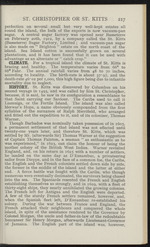 |
“...its coloniser, Thomas
Warner.,
Though Barbados was nominally taken possession of in 1605,
a permanent settlement of that island was not effected until
twenty-one years later, and therefore St. Kitts, which was
settled by Mr. (afterwards Sir) Thomas Warner at the suggestion
of Captain Thomas Painton, a seaman “ as enthusiastic as he
was experienced,” in 1623, can claim the honour of being the
mother colony of the British West Indies. Warner revisited
England, and, on his return in 1625 with a number of settlers,
he landed on the same day as D’Esnambuc, a privateering
sailor from Dieppe, and in the face of a common foe, the Caribs,
the English and the French colonists settled down side by side,
the former in the middle of the island and the latter at either
end. A fierce battle was fought with the Caribs, who though
numerous were eventually decimated, the survivors being chased
into the sea. The Spaniards resented the French and English
establishing themselves so strongly, and in 1629, with...”
|
|
| 20 |
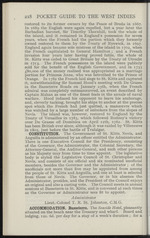 |
“...1782 the French laid siege to St. Kitts and captured
it, notwithstanding Sir Samuel Hood’s meeting with De Grasse
in the Basseterre Roads on January 25th, when the French
admiral was completely outmanoeuvred, an event described by
Captain Mahan as one of the finest feats in the annals of naval
warfare. Hood induced his opponent to leave his anchorage,
and, cleverly tacking, brought his ships to anchor at the precise
spot which the French had just quitted, a manoeuvre which
was watched by a large number of onlookers from the slopes of
Nevis. The island was, however, restored to England by the
Treaty of Versailles in 1783, which followed Rodney’s victory
over De Grasse off Dominica on April 12th, 1782. St. Kitts
has been British ever since, although it was raided by Villeneuve
in 1805, just before the battle of Trafalgar.
CONSTITUTION'. The Government of St. Kitts, Nevis, and
Anguilla is administered by an officer entitled the Administrator.
There is one Executive Council for the Presidency,...”
|
|
